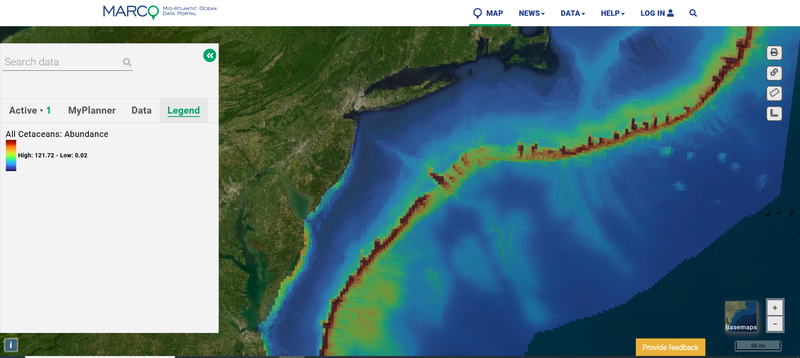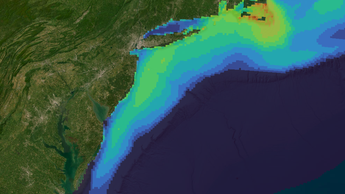Hundreds of New Monthly Marine Mammal Data Products Reflect Recent Observations and Updated Modeling Methods
In collaboration with the Northeast Regional Council on the Ocean and the Marine life Data & Analysis Team (MDAT), the cetacean data products on the Mid-Atlantic Ocean Data Portal have been updated to reflect the latest model outputs developed by the Duke University Marine Geospatial Ecology Lab (MGEL; Roberts et al. 2023). The Roberts et al. (2023) cetacean models have been cited extensively and are being used by agencies and stakeholders to understand marine mammal distribution and abundance in the context of agency proposed actions in U.S. Atlantic waters. The new layers include several improvements to the previous models and now include seal (pinniped) density model outputs for the first time.

Above: The resolutions have been doubled from previous versions of Marine Mammal group maps like the above All Cetaceans: Abundance layer.
The full suite of 31 updated density models for 26 cetacean species and five species guilds produced using updated methodology and survey data conducted through 2020 is now available to view in Marine Planner. Maps layers showing cetacean groups (e.g. All Cetaceans, Baleen Whales) can be found in the Marine Life theme by clicking on the “Marine Mammals” dropdown. Maps showing individual species (e.g. Humpback Whales, Bottlenose Dolphin) can be generated using the search widget in the Marine Life Library (Species Specific) theme.
Cetacean data products on the Portal have been updated several times since 2016. Past updates have incorporated improvements to the individual species model outputs as well as refinements to “summary products”, which includes layers depicting the total abundance and species richness of ecological groups, species of concern, and stressor (e.g., sound sensitivity) groups. Some of the improvements to the cetacean data products with this update include:
- The total amount of survey data integrated into the models increased significantly—by 255% for aerial effort and 93% for shipboard effort.
- Spatial resolution was increased to 5km x 5km grid cells for all individual species and summary product layers, while the prediction units remain the number of animals/100km2. Individual species values are density.
- The color scheme for both individual species and summary products was changed from Viridis to Turbo. A summary of the differences and improvements with Turbo can be found here.
- For the first time, a towed passive acoustic monitoring survey (MCR SOTW Acoustical) was incorporated. This survey was used in models for sperm whales and beaked whales.
- The seal model is now included in the MDAT release.
- A new (non-stratified) density surface model for blue whale was generated and included in the summary product calculations for all relevant species groups.
- The new model extent/study area no longer includes the Laurentian Channel but now extends in the Mid-Atlantic to include the Balanus Seamount and offshore of Blake Spur in the southeast. Additionally, the study area was extended further inshore in certain bays and estuaries, per NOAA’s request.
- The uncertainty methodology was updated and the resulting estimates now account for interannual variability. (Previous versions only accounted for the estimated statistical error in model parameter estimates.)
- Humpback whale model has been removed from ESA-listed species group, per NOAA declassification.
A complete accounting of the model version history, plus additional details on the individual species models and summary products can be found on the MDAT website. For specific details on the updates to each individual species model for marine mammals in U.S. Atlantic waters, see below and visit the Duke MGEL model repository page.

References
Roberts J.J., Yack T.M., Halpin P.N. 2023. Marine mammal density models for the U.S. Navy Atlantic Fleet Training and Testing study area for the Phase IV Navy Marine Species Density Database. Document version 1.3. Report prepared for Naval Facilities Engineering Systems Command, Atlantic by the Duke University Marine Geospatial Ecology Lab, Durham, North Carolina.
Share this story